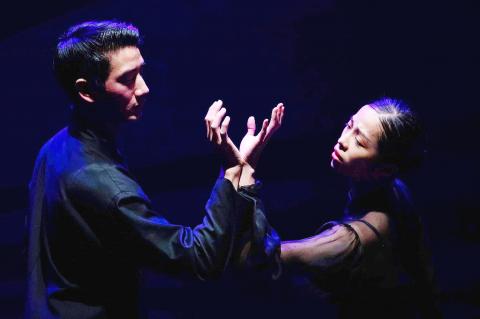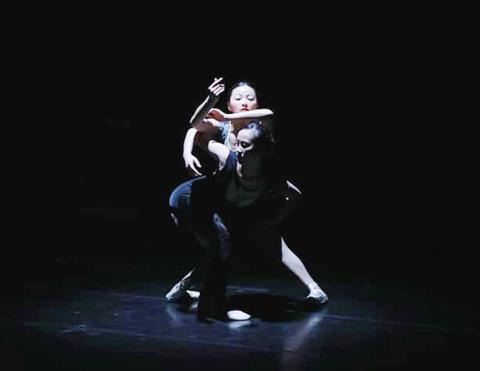An invite from Kaohsiung City Ballet (KCB, 高雄城市芭蕾舞團) to see this year’s Dance Shoe production (2019點子鞋) in Tainan on Saturday was worth the trip down south, despite the overall unevenness of the production.
While the 16th edition of the show was not as strong overall as its predecessors, and darkness seemed to be the underlying theme, there was still a lot to appreciate from both choreographers and dancers.
The highlight of the show was Lee Jeong-yun’s Alone Together, danced by Chiu Chu-en (邱主恩) and Hsiao Yi-han (蕭翊涵).

Photo: Courtesy of Liu Ren-haur
A darkly romantic duet about lovers destined to be parted, Alone Together is set to Frederic Chopin’s Ballade No. 1, a piano piece known for being among the most challenging in a pianist’s repertoire.
The sweeping score is tailor-made for dramatic lifts and carries, and Lee, an experienced South Korean choreographer who is a visiting professor at Taipei National University of the Arts (TNUA), showed a deft skill and musicality that can only come with experience.
It was terrific to see Chiu again after his memorable performance in the role of War in the Formosa Ballet’s production of Lost Illusion last year. Chiu, a TNUA graduate who also studied at the Kirov Academy in Washington, is a wonderful dancer who every ballet choreographer in Taiwan should be rushing to use.

Photo: Courtesy of Daniel Chuang
Hsiao was equally lovely to watch, and Lee’s piece gave her a more of chance to show her dramatic skills and fine lines than Wei Tzu-ling’s (魏梓錂) Dominator earlier in the program.
Lee is choreographing a piece for Hsiao's master's of fine arts concert in early June as well as one for TNUA’s high school concert in June next year and I look forward to seeing both.
Dominator was Wei’s second work for a Dance Shoe production after last year’s Jianxi (間 隙) and like last year’s piece, set to Ravi Shankar and Philip Glass’ Offering, Wei chose equally intriguing music, this time three pieces by Sylvain Chauveau.
Hsiao was partnered by Wendy Yang (楊雅媛), and Wei took full advantage of the pair’s long legs, highlighted by short-skirted costumes, in choreography that saw the two parry and spar in a mix of duet and solo dancing — and challenged their balancing skills with hops on and off two small box structures.
However, while the piece started off strong, it did not really go anywhere and I was left with a sense of untapped potential.
The only solo on the program, Chien Lin-yi’s (簡麟懿) Sway Me, danced by Tzeng Tzu-yin (曾子音), was inspired by the writings of Chinese poet Yu Xiuhua (余秀華). Chien, whose previous works have been solos for himself, said he wanted the experience of being able to step back and view the work from outside.
His effort paid off and Sway Me showed that he is developing a choreographic style that is uniquely his own.
Tzeng was fascinating to watch, but I kept think that I could also see Chien, a terrific dancer, performing this piece as well, as it would work well on either a woman or a man.
The opening work, Li Zong-lin’s (李宗霖) Wuqiao (無殼, “Shell-less”), performed by Cheng Hsuan-ling (陳宣伶) and Lai Si-ying (賴思穎), was another piece that had an interesting intro, with Cheng and Lai slowly curling and unfurling around one another as they gradually moved toward center stage, but in the end it did not meet the promise shown by the opening.
Li, a terrific dancer himself, is just starting to try his hand at choreographing, and Wuqiao did make me want to see more from him.
The final work on the program was by Hsieh Pei-shan (謝佩珊), founder of the three-year-old HPS Dance Theater, and X Guanxi (X 關係, “X Relationship”) proved to be the least balletic of the lot, with a lot of street-dance and contemporary movement.
The piece featured KCB veteran Ally Yeh (葉麗娟), Bai Yen-yu (白顏毓), frequent HPS dancer Yu Chung-yu (余忠諺) and a large rolling armchair, but most of the action was between Bai and Yu. There were some complicated lifts of Yeh by the men, either singly or together, but some of the more complicated ones appeared forced, rather than seamlessly smooth, which I put it down to the men’s inexperience, as Yeh gamely persevered through it all.
My biggest complaint about X Guanxi was that it was predictable. Halfway through I was pretty sure how it would end, and I was right.
This story has been updated since it was first published to correct the works that South Korean choreographer Lee Jeong-yun is creating for TNUA students.

May 11 to May 18 The original Taichung Railway Station was long thought to have been completely razed. Opening on May 15, 1905, the one-story wooden structure soon outgrew its purpose and was replaced in 1917 by a grandiose, Western-style station. During construction on the third-generation station in 2017, workers discovered the service pit for the original station’s locomotive depot. A year later, a small wooden building on site was determined by historians to be the first stationmaster’s office, built around 1908. With these findings, the Taichung Railway Station Cultural Park now boasts that it has

The latest Formosa poll released at the end of last month shows confidence in President William Lai (賴清德) plunged 8.1 percent, while satisfaction with the Lai administration fared worse with a drop of 8.5 percent. Those lacking confidence in Lai jumped by 6 percent and dissatisfaction in his administration spiked up 6.7 percent. Confidence in Lai is still strong at 48.6 percent, compared to 43 percent lacking confidence — but this is his worst result overall since he took office. For the first time, dissatisfaction with his administration surpassed satisfaction, 47.3 to 47.1 percent. Though statistically a tie, for most

Wooden houses wedged between concrete, crumbling brick facades with roofs gaping to the sky, and tiled art deco buildings down narrow alleyways: Taichung Central District’s (中區) aging architecture reveals both the allure and reality of the old downtown. From Indigenous settlement to capital under Qing Dynasty rule through to Japanese colonization, Taichung’s Central District holds a long and layered history. The bygone beauty of its streets once earned it the nickname “Little Kyoto.” Since the late eighties, however, the shifting of economic and government centers westward signaled a gradual decline in the area’s evolving fortunes. With the regeneration of the once

In February of this year the Taipei Times reported on the visit of Lienchiang County Commissioner Wang Chung-ming (王忠銘) of the Chinese Nationalist Party (KMT) and a delegation to a lantern festival in Fuzhou’s Mawei District in Fujian Province. “Today, Mawei and Matsu jointly marked the lantern festival,” Wang was quoted as saying, adding that both sides “being of one people,” is a cause for joy. Wang was passing around a common claim of officials of the People’s Republic of China (PRC) and the PRC’s allies and supporters in Taiwan — KMT and the Taiwan People’s Party — and elsewhere: Taiwan and